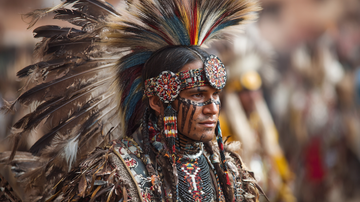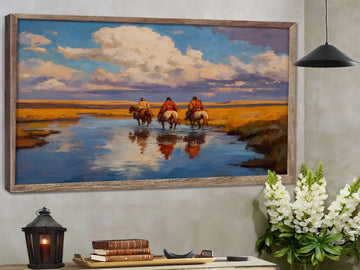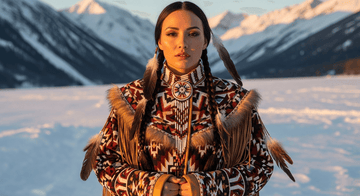The rhythmic drumbeat echoes across the gathering, feathers dance in the sunlight, and generations of tradition come alive through the sacred art of powwow regalia. Native American ceremonial wear represents far more than beautiful clothing—it embodies centuries of cultural heritage, spiritual significance, and artistic expression that continues to thrive in modern powwow celebrations.

Understanding the profound meaning behind powwow regalia opens a window into the rich tapestry of Native American culture. Whether you're preparing to attend your first powwow, seeking to appreciate Native American artistry, or exploring ways to respectfully honor these traditions, this comprehensive guide will illuminate the sacred world of ceremonial wear and its enduring significance in Indigenous communities.
The Sacred Significance of Powwow Regalia
Powwow regalia—never referred to as "costumes"—represents a deeply personal and spiritual connection to ancestral traditions. Each piece of regalia tells a story, carrying forward family heritage, tribal identity, and individual spiritual journey. The intricate beadwork, sacred feathers, and traditional materials used in regalia creation represent thousands of hours of skilled craftsmanship and profound cultural meaning.
The cultural significance of regalia extends beyond aesthetic beauty. These handcrafted garments serve as a bridge between past and present, connecting contemporary Native Americans to their ancestors while expressing personal and tribal identity. The colors, patterns, and materials chosen for regalia often reflect specific tribal traditions, family histories, and spiritual beliefs passed down through generations.

For those seeking to honor and support Native American culture, understanding the sacred nature of regalia is essential. Many contemporary Native Americans and supporters choose to wear traditional-inspired jackets and outerwear that respectfully incorporate Indigenous design elements without appropriating sacred regalia patterns.
Traditional Men's Regalia Styles
Men's powwow regalia encompasses several distinct dance styles, each with its own traditional clothing requirements and cultural significance. These styles have evolved over centuries while maintaining their essential spiritual and cultural elements.
Traditional Men's Regalia
Traditional men's regalia represents the oldest and most sacred form of powwow dress. Dancers wear breastplates made from bone or shells, roaches crafted from porcupine or deer hair, and regalia adorned with traditional quillwork or beadwork. The outfit typically includes a breechcloth, leggings, and high-top moccasins, often decorated with meaningful tribal symbols and family designs.
The roach headdress, a distinctive feature of men's traditional regalia, requires careful construction and maintenance. Feathers attached to the roach often hold specific spiritual significance, and the entire headdress may be passed down through generations as a family heirloom.
Grass Dance Regalia
Grass dance regalia features long fringes of yarn or ribbon that flow with the dancer's movements, creating a mesmerizing wave-like effect. This style originated from Plains tribes and represents the swaying of prairie grass in the wind. The regalia typically includes a fringed shirt, apron, and accessories decorated with traditional colors and patterns.
Fancy Dance Regalia
Fancy dance regalia is characterized by elaborate feather bustles, colorful designs, and dynamic movement accessories. This more contemporary style allows for greater individual expression while maintaining cultural authenticity. Dancers wear two bustles—one at the back and one at the neck—along with brightly colored regalia that showcases the dancer's athletic skill and artistic vision.

Women's Regalia Traditions
Women's powwow regalia reflects the grace, strength, and spiritual connection of Native American women throughout history. Each style carries its own cultural significance and traditional elements that have been preserved and adapted across generations.
Traditional Women's Regalia
Traditional women's regalia features beautiful buckskin dresses or trade cloth garments adorned with meaningful beadwork, quillwork, shells, and ribbon. These elegant outfits often include dentalium shells, elk teeth, or other traditional materials that hold cultural significance. Women typically carry a shawl draped over their arm and a feathered fan while dancing in a stationary, dignified manner.
The craftsmanship involved in creating traditional women's regalia requires extensive knowledge of traditional techniques and materials. Many families pass down specific patterns and designs that represent their tribal heritage and family history.
Jingle Dress Regalia
The jingle dress holds special significance as a symbol of healing and resilience. Adorned with rows of metal cones that create a distinctive sound during dance, the jingle dress traditionally serves as a sacred healing garment. The dress originated from an Ojibwe vision and has spread throughout Native American communities as a powerful symbol of spiritual medicine and cultural continuity.

Fancy Shawl Regalia
Fancy shawl regalia features elaborately beaded capes, moccasins, and leggings worn with appliquéd shawls that have long fringe around the edges. This colorful and dynamic style allows women to express their individual creativity while honoring traditional elements. The shawl itself becomes an extension of the dancer's movement, creating flowing patterns that complement the dance steps.
Cultural Etiquette and Respect
Understanding proper powwow etiquette is essential for anyone wishing to respectfully participate in or observe these sacred gatherings. The rules of conduct ensure that the spiritual and cultural significance of powwows is maintained while welcoming visitors to learn and appreciate Native American traditions.
Essential Dos and Don'ts
When attending powwows or engaging with Native American culture, certain guidelines ensure respectful participation:
Always refer to ceremonial clothing as "regalia," never as "costumes"
Never touch a dancer's regalia without explicit permission
Stand and remove hats during Grand Entry and honor songs
Dress modestly and respectfully when attending powwows
Ask permission before photographing dancers or their regalia
Follow the lead of Native American participants in all ceremonial activities
Show respect for elders and follow their guidance
If a dancer drops any piece of regalia, visitors should not pick it up but instead notify powwow staff for assistance. This protocol ensures that sacred items are handled appropriately by those who understand their significance.
Appropriate Attire for Non-Native Visitors
Non-Native visitors should dress respectfully when attending powwows. Men should wear ribbon shirts and slacks, while women should wear modest dresses or skirts. Everyone should wear close-toed shoes and avoid clothing with inappropriate imagery or offensive messages.
For those seeking to show respect and appreciation for Native American culture in their daily lives, choosing authentic Native American-inspired home decor and traditional accessories from Indigenous artists and culturally respectful sources supports Native communities while honoring their artistic traditions.

The Art of Regalia Creation
Creating authentic powwow regalia requires extensive knowledge of traditional techniques, materials, and cultural protocols. Many Native American families dedicate months or even years to crafting regalia, with knowledge passed down through generations of skilled artisans.
Traditional Materials and Techniques
Traditional regalia incorporates natural materials such as leather, feathers, shells, bone, and plant fibers. Beadwork, quillwork, and ribbon work represent highly specialized skills that require years of practice to master. Each technique carries cultural significance and often reflects specific tribal traditions and artistic styles.
The process of creating regalia involves not only technical skill but also spiritual preparation and cultural understanding. Many artisans pray and conduct ceremonies throughout the creation process, imbuing their work with spiritual power and cultural meaning.
Contemporary Adaptations
While maintaining traditional elements, contemporary regalia makers often incorporate modern materials and techniques to create durable, comfortable, and visually stunning pieces. This evolution reflects the living nature of Native American culture, which continues to adapt and grow while preserving essential traditions.
Modern Native American artists also create contemporary interpretations of traditional designs for everyday wear, including cultural inspired jackets and outerwear that allow people to honor Native American artistry in appropriate, respectful ways.

Supporting Native American Artists and Culture
Respectful appreciation of Native American culture involves supporting Indigenous artists, learning about historical and contemporary issues, and advocating for Native American rights and sovereignty. When seeking to honor Native American traditions, it's essential to purchase authentic items from Native American artisans and culturally responsible sources.
Authentic vs. Appropriation
Understanding the difference between cultural appreciation and appropriation is crucial for respectful engagement with Native American culture. Authentic appreciation involves learning about the cultural significance of traditions, supporting Native American artists and communities, and respecting the sacred nature of ceremonial items.
Cultural appropriation occurs when sacred symbols, designs, or practices are used without permission or understanding, often for commercial gain without benefiting Native American communities. By choosing to support authentic Native American artists and businesses, consumers can enjoy beautiful, meaningful items while contributing to the preservation and continuation of Indigenous cultures.
Where to Find Authentic Native American Items
When seeking Native American-inspired items for personal use, it's important to choose sources that work directly with Native American artists and communities. Look for businesses that clearly identify their Indigenous partnerships and provide information about the cultural significance of their products.
For those interested in incorporating Native American-inspired design elements into their lifestyle, consider exploring authentic home decor collections that feature traditional patterns and symbols created in respectful collaboration with Native American artists. Similarly, traditional accessories and jewelry created by Indigenous artisans offer meaningful ways to appreciate and support Native American craftsmanship.

Powwow Participation and Cultural Learning
Participating in powwows as a respectful observer or learning about Native American culture through authentic sources provides valuable opportunities for cultural exchange and understanding. Many powwows welcome visitors and offer educational opportunities to learn about Native American history, traditions, and contemporary issues.
Educational Opportunities
Many powwows include educational components such as cultural demonstrations, storytelling, and informational displays. These opportunities provide valuable insights into Native American history, traditional practices, and contemporary culture. Visitors can learn about the significance of different regalia styles, the meaning behind specific dances, and the ongoing importance of powwows in Native American communities.
Educational programs often highlight the diversity of Native American cultures, helping visitors understand that there are hundreds of distinct tribes, each with their own traditions, languages, and cultural practices. This knowledge helps combat stereotypes and promotes accurate understanding of Native American peoples and cultures.
Building Cultural Bridges
Respectful engagement with Native American culture can help build understanding and support for Indigenous communities. By learning about the historical and contemporary challenges faced by Native American peoples, visitors can become advocates for Indigenous rights and sovereignty.
Many Native American communities welcome respectful interest in their cultures and traditions, viewing cultural exchange as an opportunity to educate others and build supportive relationships. This mutual respect and understanding benefits both Native American communities and the broader society.

The Future of Native American Ceremonial Traditions
Native American ceremonial traditions continue to evolve and adapt while maintaining their essential cultural and spiritual significance. Young Native Americans are learning traditional skills from elders, creating new interpretations of classical designs, and finding innovative ways to share their cultures with the broader world.
Preserving Traditional Knowledge
The preservation of traditional knowledge about regalia creation, ceremonial practices, and cultural protocols remains a priority for many Native American communities. Elder practitioners work closely with younger generations to ensure that essential skills and cultural understanding are maintained and passed on.
This knowledge transfer includes not only technical skills but also the spiritual and cultural context that gives meaning to traditional practices. Understanding the stories, ceremonies, and beliefs associated with regalia and powwow traditions ensures that these practices remain authentic and meaningful for future generations.
Contemporary Expressions
Contemporary Native American artists are finding new ways to express traditional themes and values through modern mediums and techniques. This creativity ensures that Native American culture remains vibrant and relevant while honoring ancestral traditions.
Modern interpretations of traditional designs can be found in various contemporary items, from fashion-forward jackets and outerwear that incorporate traditional patterns to home decor items that bring Native American artistry into modern living spaces. These contemporary expressions help keep Native American culture visible and appreciated in contemporary society.
Conclusion: Honoring the Sacred Through Respectful Appreciation
The world of Native American ceremonial wear offers a profound glimpse into the rich cultural heritage and spiritual traditions of Indigenous peoples. From the intricate beadwork of traditional regalia to the flowing fringes of grass dance outfits, each element carries deep meaning and represents centuries of cultural continuity.
Understanding and respecting the sacred nature of powwow regalia allows us to appreciate the artistry, spirituality, and cultural significance of these magnificent traditions. Whether attending a powwow, supporting Native American artists, or simply learning about Indigenous cultures, we have the opportunity to engage respectfully with these living traditions.
By choosing to support authentic Native American artisans and businesses, we can enjoy beautiful, meaningful items while contributing to the preservation and continuation of Indigenous cultures. From traditional-inspired outerwear to authentic home decor and accessories, there are many ways to honor Native American artistry while supporting Indigenous communities.

As we continue to learn about and appreciate Native American cultures, we must remember that these traditions are not relics of the past but living, evolving expressions of vibrant communities. Through respectful engagement, continued education, and support for Indigenous artists and communities, we can help ensure that these sacred traditions continue to thrive for future generations.
The journey of understanding Native American ceremonial wear is ongoing, filled with opportunities for learning, growth, and meaningful cultural exchange. By approaching these traditions with respect, humility, and genuine desire to learn, we can contribute to a more inclusive and understanding world where Indigenous cultures are celebrated and preserved for generations to come.
"Regalia is not just clothing—it's a connection to our ancestors, a celebration of our identity, and a bridge to our future. When we wear our regalia, we carry forward the prayers, dreams, and hopes of all who came before us."
— Traditional Native American Teaching
Explore authentic Native American-inspired designs and support Indigenous artisans through our carefully curated collections of cultural outerwear, traditional home decor, and meaningful accessories. Each purchase helps preserve and celebrate the rich artistic traditions of Native American peoples while honoring their cultural heritage with the respect it deserves.




